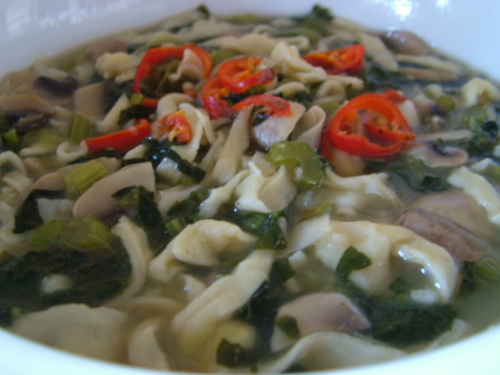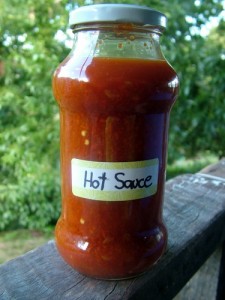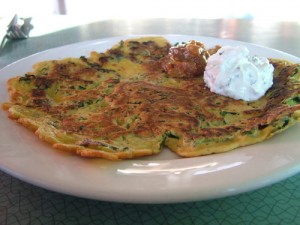End of winter, it’s been a hard few months, and I don’t often get sick, but I feel like I might. Phó is my go-to dinner when I feel like I need to ward off I-don’t-know-what. This isn’t a real Phó, but it’s got that ginger/garlic/chili/anise/cinnamon/lemon grass spice profile that my immune system seems to crave. And it uses lots of Chinese cabbage and kale, that I have in bulk even in my very neglected garden. And egg noodles – the chooks are already in spring mode and laying (the ducks and geese too). This comes together in the half hour of the Tuesday Night Vego Challenge rules, even including noodles from scratch.
The Recipe:
For two big dinner sized bowls.
Put a big pot or a pressure cooker on to boil with 5 cups of vegie stock. While it is coming to the boil, make the egg noodle dough.
1. The Egg Noodle Dough:
Egg noodles are just pasta. The story is that Marco Polo brought them back to Italy where they became spaghetti. Easy to make, and so easy to make a small quantity that I don’t even bother to pull out the pasta maker.
In a food processor, blend for just a minute till it comes together into a dough:
- ½ cup baker’s flour (high gluten flour) You can use wholemeal flour if you like.
- an egg,
- a spoonful of light flavoured oil like grapeseed oil,
- a good pinch of salt.
Knead for just a minute to make a dough ball, then let it rest while you make the soup stock. To stop it drying out, I cover the dough ball with a wet cup upside down over it.
2. The Stock:
You’re going to strain it, so nothing needs to be elegantly chopped. Into the boiling stock add:
- 1 onion, roughly chopped
- 4 cloves of garlic, roughly chopped
- a good thumb sized knob of fresh ginger, finely sliced
- a thumb of galangal (if you have it), finely sliced
- a stalk of lemon grass, chopped,
- a chili, sliced
- one inch of cinnamon stick
- one clove of star anise
- one or two bay leaves
- the leaves from a couple of stalks of celery
- the greens from a spring onion
Simmer for around 20 minutes, or pressure cook for about 7 minutes. Then strain the stock, pressing down with a potato masher to get all the juice out. Return it to the pot and bring it back up to the boil.
3: The Noodles:
 While the stock is cooking, roll out the noodle dough. If you flour the bench top well, and keep flipping it, you should be able to get it very thin. Flour the sheet of dough and fold it over a few times, then, using a sharp knife, cut it into noodles.
While the stock is cooking, roll out the noodle dough. If you flour the bench top well, and keep flipping it, you should be able to get it very thin. Flour the sheet of dough and fold it over a few times, then, using a sharp knife, cut it into noodles.
Tease the noodles to separate them.
3. The Soup
By now the stock should be ready to strain and bring back to the boil. Add to it:
- one spring onion whites, very finely sliced
- 2 stalks of celery, very finely sliced
- 1 (packed) cup of Chinese cabbage, very finely sliced
- 1 (packed) cup of cavolo nero kale, very finely sliced
- 2 cups of mushrooms, finely sliced.
Simmer for another 5 minutes, or pressure cook for a couple of minutes, then add the noodles and simmer for just a couple of minutes more.
Taste and add soy sauce and/or lime juice to taste (or just allow people to add their own).




I love pho, but then I have it on tap living in the Inner West of Sydney. Thanks for the recipe but since I am in a constant state of ready access to pho, I scarcely think I will make it! I hope you enjoyed and felt it warding off the last of the season’s bugs.
I’m with Louise, I miss living in Strathfield and Chatswood and having excellent pho only a 5 minute walk away. Still, I agree that when you’re feeling poorly a bowl of hot broth with lots of ginger is a good way to warm up.
We had dry potato curry and lentil dahl on Tuesday night, and tonight we’re having chilli beans (using a mixture of pinto beans and kidney beans).
Yum, I love pho (or my version of it). You’ve inspired me to make my own noodles next time too.
Pingback:Fettucini With Kale Pesto
Pingback:Spicy Kale Pancake